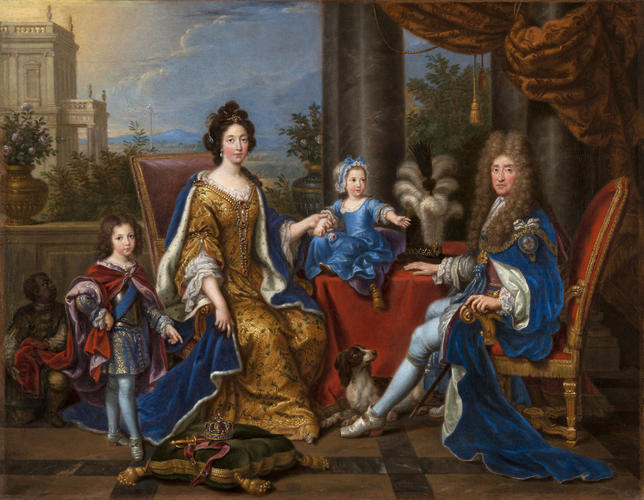-
1 of 253523 objects
Oil on canvas | 46.4 x 59.8 x 1.9 cm (support, canvas/panel/stretcher external) | RCIN 400966
-
In this painting Pierre Mignard depicts Britain’s alternative royal family. Following the Glorious Revolution of 1688, the Catholic King James II (1633–1701), his consort Mary of Modena (1673–1718) and their newborn son, James Francis Edward (1688–1766), were forced to leave England for France. James’s first cousin, French King Louis XIV, provided them with the Château de Saint-Germain-en-Laye, close to Versailles, and here the Stuart King lived in great splendour, maintaining much of the ceremony of the English court. Despite being prepared to return to England in the same way that his brother Charles II had done in 1660, neither James II nor his son and grandson – the ‘Old’ and the ‘Young Pretenders’ – succeeded in regaining the British throne.
James II is shown enthroned and dressed in the full regalia of the Order of the Garter. Queen Mary, also seated on an armchair, wears a yellow-gold dress embroidered with flowers and contrasted with an ermine-lined blue mantle pinned to her shoulders. At the centre of the picture, sits their two-year-old daughter Princess Louisa Maria Teresa holding a rose – a reference to the Royal Badge of England, which James II continued to use in exile. On the other side of the Queen stands her six-year-old son James, dressed in armour adorned with the blue Order of the Garter sash, pointing to a green velvet cushion upon which rest a small-scale Imperial crown and sword. The painting alludes to the education of the aspirant Prince of Wales, who was being prepared to return to Britain in order to claim the Crown – which was clearly made to fit him. On the far left is a fifth figure, a young Black servant whose identity is not known. He wears a green Roman style tunic and is shown kneeling in a deferential pose, looking up to the young Prince and holding his red cloak off the ground.
This work is usually considered to be by Mignard himself; it is either a modello (preparatory oil-sketch) or a ricordo (reduced replica or ‘recollection’) of a larger composition. The commission for this larger work was probably inspired by Mignard’s 1687 group portrait of the Dauphin’s family (Versailles), of which there is a replica in the Royal Collection (RCIN 404490). The ‘English family’ was Mignard’s last important work; he carried out numerous preparatory sketches for it (Louvre Cabinet des Dessins) and completed it in November 1694, months before his death. Perhaps because of the artist's frail condition, the sittings took place at different places; they were witnessed by numerous courtiers, and on one occasion by Louis XIV himself. The canvas travelled from the artist’s studio to Saint-Germain, then to Versailles and finally back to the studio, where the old and feeble painter put his finishing touches. The full size portrait was recorded in Mignard’s studio after his death in 1695 (measuring 245 x 290cm) and in the estate of James II after his death in 1703. It is now believed to be in a Private collection. This smaller version is not documented before the 19th century.Provenance
Presented to Edward VII when Prince of Wales by the Marquis de Breteuil, 20 April 1894
-
Creator(s)
Acquirer(s)
-
Medium and techniques
Oil on canvas
Measurements
46.4 x 59.8 x 1.9 cm (support, canvas/panel/stretcher external)
66.2 x 76.7 x 10.7 cm (frame, external)
Category
Object type(s)
Alternative title(s)
James II and Family
Portrait of James II and his Family at St. Germain
